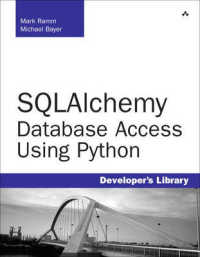- ホーム
- > 洋書
- > 英文書
- > Cinema / Film
Full Description
So far, the study of cinema has been overwhelmingly visual. Robert Robertson instead presents cinema as an audiovisual medium, based on Sergei Eisenstein's ideas on the montage of music, image and sound. Cinema and the Audiovisual Imagination applies an audiovisual focus to films by directors such as Spike Lee, Maya Deren, David Lynch, Alfred Hitchcock, Stanley Kubrick, Fritz Lang, Luis Buñuel, Pier Paolo Pasolini, Werner Herzog, David Lean and Sergei Eisenstein. In addition, Eisenstein's concept of 'nonindifferent' nature is extended to films beyond the European tradition - by Satyajit Ray, Kaneto Shindo, Akira Kurosawa and Chris H. Lynn- and the audiovisual and landscape is explored in films by Dziga Vertov, Andrei Tarkovsky, Sergei Paradjanov, Bruce Conner, Jack Chambers, Derek Jarman and Alexander Sokurov. The audiovisual in avant-garde animation by John and James Whitney, Len Lye, Norman McLaren and in the film experiments of Busby Berkeley are considered too. Responding to recent developments in technology which have enabled practitioners to work extensively with music and sound on an equal level with the visual track, the book also examines the audiovisual creative process in opera, in a music/film collaboration with Dennis Dracup and in Robertson's own music/film Oserake and The River That Walks.
Contents
List of Illustrations
Acknowledgements
Preface
Introduction
1. Do The Eisenstein Thing: The Audiovisual in Spike Lee's Do the Right Thing (1989)
2. Double Echoes: Music and Sound in David Lynch's Lost Highway (1997)
3. Audiovisual Irony, Terror, Ecstasy: David Lean:This Happy Breed (1944), Alfred Hitchcock: The Birds (1963), Werner Herzog: Land of Silence and Darkness (1971)
4. Where's The Film Composer?: Music, Image and Sound in Stanley Kubrick's 2001 - a Space Odyssey (1968)
5. Filmic Choreographies: A Backward Glance: John and James Whitney, Len Lye, Norman McLaren, Busby Berkeley
6. Maya Deren - Meshes of the Audiovisual: Music, Image and Sound in Maya Deren's Meshes of the Afternoon (1959)
7. The Audiovisual Imagination Beyond the European Tradition: Satyajit Ray: Devi (1960), Kaneto Shindo: Onibaba (1964), Akira Kurosawa: Throne of Blood (1957)
8. Sonic Art, Digital Cinema - Chris H. Lynn: A Trilogy of Summer (2010-2012)
9. Two Films With Little Music: Fritz Lang: M (1931), Alfred Hitchcock: Rope (1948)
10. The Audiovisual in Three Found Footage Films: Dziga Vertov: Three Songs of Lenin (1934), Bruce Conner: Crossroads (1976), Jack Chambers: Hart of London (1968-1970)
11. Two Audiovisual Collages: Pier Paolo Pasolini: The Gospel According to Matthew (1964), Sergei Paradjanov: The Legend of the Surami Fortress (1984)
12. 'The echo of many voices': Derek Jarman's Blue (1993)
13. Three Russians, the Audiovisual, and the Long Take: Sergei Eisenstein: Ivan the Terrible, Part 1 (1944),
Andrey Tarkovsky: The Sacrifice (1986), Alexander Sokurov: Mother and Son (1997)
14. Empedocles, Intertransparency and the Leaping Elements: Robert Robertson and Dennis Dracup: Empedocles (1995)
15. Diary of a Music/Film: Robert Robertson: Oserake and The River That Walks (2002)
Notes
Bibliography







